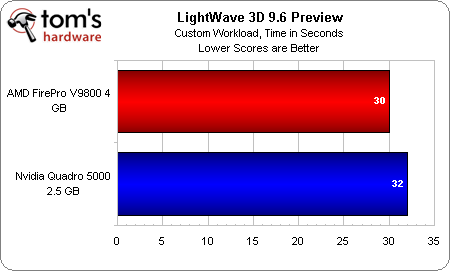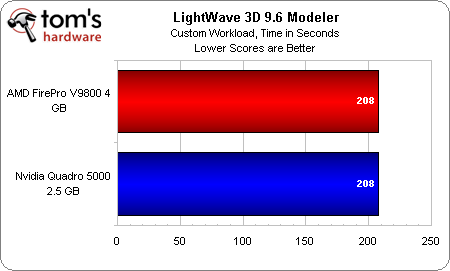AMD FirePro V9800 4 GB: Eyefinity Meets Professional Graphics
What's red, black, sports 4 GB of GDDR5, and has DisplayPort outputs all over? AMD's FirePro V9800, the company's ultra-high-end workstation card. We run it through a battery of SPECapc and real-world performance tests, then compare it to Quadro 5000.
Benchmark Results: 3ds Max 2010 And LightWave 9.6
In addition to the SPECapc tests, we wanted to take 3ds Max and LightWave for a spin using real-world workloads.
Whereas the SPEC tests take a variety of measurements and wrap them into composite scores, we simply timed two tests. One employs the default scanline renderer and the other uses the mental ray renderer.
Unfortunately, neither benefits from GPU-based acceleration, like the Arion light simulator (optimized for CUDA). The result is two very similar scores across both cards.
The OpenGL-based LightWave preview finishes just a tad quicker on the FirePro card, while the very CPU-dependent Modeler workload finishes in the same amount of time.
From there, we rendered four individual frames from our Tom's Hardware logo test:
| LightWave 9.6 Frame Render | AMD FirePro V9800 | Nvidia Quadro 5000 |
|---|---|---|
| Frame #8 | 9:45 | 9:44 |
| Frame #41 | 10:11 | 10:11 |
| Frame #500 | 11:20 | 11:19 |
| Frame #600 | 8:08 | 8:07 |
Again, we're looking at a processor-bound scenario. It all goes to show that, even in a workstation environment, building with balance in mind is a smart decision. Want more proof? Check out the Xeon 5600-based benchmarks that demonstrate how well LightWave rendering scales with as many as 24 threads.
Get Tom's Hardware's best news and in-depth reviews, straight to your inbox.
Current page: Benchmark Results: 3ds Max 2010 And LightWave 9.6
Prev Page Benchmark Results: Vue, Cinebench, MatchMover, And Blender Next Page Power Consumption-
Nvidia shines in the industrial/commercial/scientific market, with their driver team and CUDA/GPGPU tech. Too bad the V9800 fell short of expectations. Also, Nividia cards are obviously going to have better results in Adobe Mercury since both companies worked together on hardware optimization. AMD needs to be more aggressive in working together with software makers, (including games!) to have a stronger hold on both the CPU and GPU markets. Overall, a good read.Reply
-
reprotected It would actually make sense if they compared with the V8800 and the Quadro 6000. We also need a review of the Quadro 4000, 2000 and the 800, along with the lower Firepro 3D series.Reply -
reprotectedIt would actually make sense if they compared with the V8800 and the Quadro 6000. We also need a review of the Quadro 4000, 2000 and the 600, along with the lower Firepro 3D series.1. Definetly, a review of the "lower end" cards would be nice.Reply
2. Plus, it would be nice to see how well the SLi cards scale.
3. Also, with the updated (e)nVidia desktop cards (GF100 to GF110), will the Quadro ones see a revision too - if so, when? -
cangelini radiovan1. Definetly, a review of the "lower end" cards would be nice.2. Plus, it would be nice to see how well the SLi cards scale.3. Also, with the updated (e)nVidia desktop cards (GF100 to GF110), will the Quadro ones see a revision too - if so, when?Reply
Good question (3), I'll ask!
Cheers,
Chris -
Cwize1 This was a rather underwhelming test suit. I think the fundamental problem you have is that most of the tests you ran were CPU based.Reply
What most of these production apps use the GPU for is on the fly rendering. For example, sculpting in blender can tax the GPU quite nicely given enough vectors. Another good blender one would be playing back a super resolution baked fluid simulation in real time. For example, take the tom's hardware logo you had before, turn it into water and let the water fall onto a flat surface. Bake the simulation with a ridiculous resolution (as much as you can before blender crashes) and then play the simulation back in real time while watching 5 high definition videos at the same time. -
hell_storm2004 The FirePro has still the long way to go to catch up with the Quadro. I hope ATI makes good progress in the workstation models soon like they have come a long way in the desktop market.Reply -
eclecticfortune In this article's conclusion appeared this statement:Reply
"If you’re a creative professional working with Adobe’s CS5 suite, then the Quadro is hands-down a no-brainer."
Benchmarks indicate that the lower priced GTX 480 is a far better choice (cost effective)for those taking advantage of the Mercury Playback Engine running Premiere Pro CS5.
http://ppbm5.com/Benchmark5.html
At the top of this page, click on the "MPE Performance Chart" to get a comparison between the different Nvidia Cards with Premiere Pro CS5.




